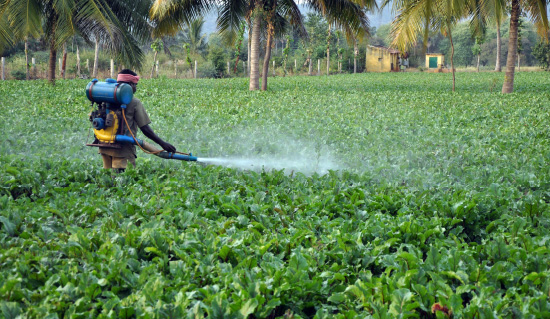முறுக்கில்லாத வாலிபர்கள், உடல் வலு இல்லாத பூப்பெய்திய பெண்கள், புது மணத்தம்பதிகள், நீடித்த நோயால் பாதிக்கப்பட்டவர்கள் என சகலருக்கும் உணவாக மட்டுமில்லாமல் மருந்தாகவும் கொடுக்கப்படுவது கோழிக்கறி. மேற்கூறிய நன்மைகளுக்கெல்லாம் உரித்தானது நாட்டுக்கோழி. விவசாய நிலங்களில் புழு, பூச்சிகளைக் கொத்தித் தின்று விட்டு நாட்டுக்கோழி இடும் கழிவு நிலத்துக்கு உரமாகவும் பயன்பட்டது. இப்படியாக ஒரு சூழலியல் தொடர் சங்கிலியைக் கொண்டிருந்தது நாட்டுக் கோழி வளர்ப்பு.
ஜெர்மனிலிருந்து இறக்குமதி செய்யப்பட்ட வொய்ட் லெகான் எனப்படும் பிராய்லர் கோழி வளர்ப்பு எப்படி இருக்கிறது, தெரியுமா? குடோனுக்குள் சூரிய ஒளியே படாமல், ஒரு கூண்டுக்குள் அடைக்கப்பட்டு வளர்க்கப்படுகிறது. குறுகிய காலத்துக்குள் அதிவேகமாக வளர வேண்டும் என்பதற்காக ஹார்மோன் ஊசிகள் போடப்படுகின்றன. அப்படியாக வளரும் கோழிகளைத்தான் இன்றைக்கு நாம் விரும்பி உண்கிறோம். இக்கோழிகளுக்கு மேற்கூறிய மருத்துவத் தன்மையெல்லாம் அறவே இல்லை. மாறாக அவை நோய்களை நமக்குத் தரவல்லவை.
இது குறித்து முதலில் அக்கு ஹீலர் உமர்ஃபாருக்கிடம் பேசினோம்... ‘‘நம் நாட்டில் பிராய்லர் சிக்கன் அறிமுகப்படுத்தப்பட்ட காலத்தில், அதனுள் புரதம் மற்றும் சில சத்துகள் அதிக அளவில் இருப்பதாக சிக்கன் கம்பெனிகளும் மருத்துவர்களும் இணைந்து அறிவித்தனர். 90களில் பிராய்லர் சிக்கனை எதிர்த்துப் பேசுவது என்பது அறிவியலையே எதிர்த்துப் பேசுவதாக பார்க்கப்பட்டது. இப்படியாக உருவகப்படுத்தப்பட்டு நம்முள் சந்தைப்படுத்தப்பட்டுக் கொண்டிருக்கும் பிராய்லர் சிக்கன் பற்றிய ஆய்வுகள் நம்மை புருவம் உயர்த்தச் செய்கின்றன.
அமெரிக்காவின் பீட்டர்ஸ்பர்க்கில் அமைந்துள்ள Duquesne பல்கலைக்கழக ஆய்வுகள் பிராய்லர் கோழியின் வளர்ச்சிக்காக பயன்படுத்தப்படும் ரோக்ஸார்ஜோன் என்ற ஹார்மோன் ஊசிகள் மனிதர்களுக்கு புற்றுநோயை உருவாக்கும் தன்மை வாய்ந்தவை என்று கூறுகின்றன. பிராய்லர் கோழியை உணவாக தொடர்ந்து உட்கொள்ளும் இந்தியர்களில் நூற்றில் 65 பேருக்கு கல்லீரல் வீக்க நோய் இருப்பதாக சென்னையில் இயங்கும் மருத்துவ ஆய்வுக்குழு சார்ந்த குடல் நோய் சிறப்பு மருத்துவர்கள் தெரிவித்துள்ளனர்.
பிராய்லர் சிக்கன் நல்லதல்ல என்கிற அடிப்படை புரிதல் எல்லோரிடமும் இருக்கிறது. அப்படியிருந்தும் அதிக அளவில் நாம் உண்ணும் பிரதான உணவாக இன்று திகழ்வது பிராய்லர் சிக்கன்தான்.
நல்ல உணவே செரிக்காத இன்றைய வாழ்க்கைமுறையில் பிராய்லர் சிக்கன் போன்ற ரசாயன உணவுகளைச் சாப்பிட்டால் என்ன ஆகும்? அது மட்டுமல்ல... ஒவ்வொருவரும் தங்களது தேவைக்கேற்ப சாப்பிடுவதுதான் சரியான முறை. பசி என்பதைத் தாண்டி ருசிக்காகச் சாப்பிடத் தொடங்கிய பிறகோ கணக்கு வழக்கில்லாமல் சாப்பிடுகிறோம்.
முன்பெல்லாம் ஒரு குடும்பத்துக்கே ஒரு கிலோ அல்லது அரை கிலோ கறி எடுத்து சமைத்துச் சாப்பிடுவார்கள். இன்றைக்கு ஒரு தனிநபர் வேறு உணவுகள் எதையும் சாப்பிடாமல், சிக்கனை மட்டுமே அரை கிலோவிலிருந்து ஒரு கிலோ வரை சாப்பிடும் கலாசாரம் வந்து விட்டது. சாப்பிடும் உணவுகள் செரிப்பதற்கான உடல் உழைப்பும் நம்மிடம் இல்லாத காரணத்தால், அவை கொழுப்பாக மாறி பருமனுக்கு வழி வகை செய்கின்றன.
பிராய்லர் சிக்கனை நாம் எதிர்ப்பதற்கான காரணங்களை அலசுவோம். பிராய்லர் கோழிகள் குறிப்பிட்ட நாட்கள் மட்டுமே உயிர்வாழும் தன்மை கொண்டவை. அதற்குள்ளாகவே அவற்றை சதைப்பிடிப்போடு, எடை கூடுதலாக்கி வளர்த்து, விற்பனை செய்து விட வேண்டும் என்கிற நிர்ப்பந்தம் பண்ணை உரிமையாளர்களுக்கு இருக்கிறது. அதனால் கோழிகளின் வேகமான வளர்ச்சிக்காக இரவு நேரங்களிலும் பல்புகளை எரிய விட்டு சாப்பிட வைத்துக்கொண்டே இருப்பார்கள். அப்படி வளர்க்கப்பட்ட எடையும் போதாமல் பிராய்லர் கோழிகளுக்காகவே தனியான சத்து மருந்துகளையும் ஊசிகளையும் பயன்படுத்தத் தொடங்கினார்கள்.
இந்தப் பயன்பாட்டின் உச்சம்தான் இன்றைக்கு அதிவேக வளர்ச்சிக்குப் போடப்படும் ஹார்மோன் ஊசிகள். மனிதர்களுக்கு ஹார்மோன் ஊசிகளைப் பயன்படுத்தினாலே பல்வேறு விளைவுகள் தோன்றுவதை தவிர்க்க முடியாது. இந்த நிலையில் குறுகிய ஆயுள் கொண்ட சிறிய கோழிகளுக்கு ஹார்மோன்களை செலுத்துவதன் மூலம், அதன் உடல் முழுவதும் பாதிப்புகள் பரவி விடுகின்றன. இந்தக் கோழியை சாப்பிடும் நம் உடலிலும் ஹார்மோன் மாற்றங்கள் ஏற்படுகின்றன.
நம் நாட்டில் நடத்தப்பட்ட பிராய்லர் கோழி பற்றிய சமீபத்திய ஆய்வு அதிர்ச்சி அளிக்கிறது. டெல்லியில் இயங்கும் 'சென்டர் ஃபார் சயின்ஸ் அண்ட் என்விரோன்மன்ட்' அமைப்பின் பொல்யூஷன் மானிட்டரிங் லேபரட்டரி மூலமாக பிராய்லர் சிக்கன் பற்றி ஆய்வு மேற்கொண்டது. இந்த ஆய்வுக்காக பிராய்லர் கோழியின் கறி, கல்லீரல் மற்றும் சிறுநீரகம் ஆகிய உறுப்புகள் எடுத்துக் கொள்ளப்பட்டன.
அதற்காக டெல்லியில் இருந்து 36 வகை மாதிரிகளும், நொய்டாவிலிருந்து 12 வகை மாதிரிகளும், குர்கானில் 8 மாதிரிகளும், ஃபரிதாபாத் மற்றும் காஸியாபாத்தில் 7 வகை மாதிரிகளும் சோதனை செய்யப்பட்டன. கோழியின் வளர்ச்சிக்காக செலுத்தப்பட்ட ஆன்டிபயாடிக் ரசாயனங்கள் கோழியின் கல்லீரலிலும் சிறுநீரகங்களிலும் தேங்கியிருந்ததை ஆய்வில் கண்டறிந்தனர். ஆய்வுக்கு எடுத்துக்கொள்ளப்பட்ட மாதிரிகளில் 40 சதவிகித கோழிகளில் பலவகை ஆன்டிபயாடிக் கலப்பும், 22.9 சதவிகித கோழிகளில் இரு ஆன்டிபயாடிக்குகளும், 17.1 சதவிகித கோழிகளில் ஒரு ஆன்டிபயாடிக் ரசாயனமும் கலந்திருப்பது கண்டுபிடிக்கப்பட்டது.
ஒன்றுக்கொன்று எதிரானதாகச் செயல்படும் ஆன்டிபயாடிக் ரசாயனங்களை கலந்து கொடுப்பது கோழிகளுக்கு வேண்டுமானால் வளர்ச்சியைத் தரலாம். மனிதர்களுக்கு கணக்கற்ற நோய்களைத்தான் தரும்.
கோழிகளின் கறியில் கலந்திருக்கும் ஆன்டிபயாடிக்குகளை போல, ஹார்மோன்களும் பல்வேறு உடல்நலச் சிக்கல்களை ஏற்படுத்துகின்றன.கோழி உருவாக்கப்பட்டு கறியாக்கப்படும் வரையிலான செயல்பாடுகளே நம்மை மலைக்க வைக்கின்றன.
அதன் பிற்பாடு அக்கறியை ருசியாக சமைத்து நம் நாக்குக்கு விருந்தளிக்க என்னென்ன செயல்பாடுகளுக்கெல்லாம் கோழிக்கறி உட்படுத்தப்படுகிறது என்பதையும் பார்க்க வேண்டும். சிக்கன் 65, சில்லி சிக்கன் என்று அடர் சிவப்பு நிறத்தில் பொரித்தெடுக்கப்பட்ட சிக்கனை வாங்கி ருசிக்கிறோம். அதன் அடர் சிவப்பு நிறத்துக்காக செயற்கை பவுடர்கள் பயன்படுத்தப்படுகின்றன. புற்றுநோயை ஏற்படுத்தும் தன்மை இது போன்று நிறத்துக்காகச் சேர்க்கப்படும் ரசாயனப் பொருளில் இருப்பதாக எச்சரிக்கிறார்கள் உலக அளவில் உள்ள ஆய்வாளர்கள்.
பொன்சியூ, எரித்ரோசின் என்கிற இரு ரசாயன நிறமிகளைப் பயன்படுத்தினால் சிவப்பு நிறம் கிடைக்கும். பிரில்லியன்ட் ப்ளூ, இண்டிகோ கார்மைன் நிறமிகள் மூலம் ஊதா நிறம் கிடைக்கும். இதுபோன்ற 8 வகை நிறங்களை ஐஸ்க்ரீம், ஃப்ளேவர்டு மில்க், பிஸ்கெட், இனிப்பு வகைகள், டின்களில் அடைத்து வரக்கூடிய பட்டாணி வகைகள், பாட்டில் பழ ஜூஸ் வகைகள், குளிர்பானங்கள் என 7 வகை உணவுகளில் மட்டுமே சேர்க்க அனுமதி உண்டு.
அதுவும் 10 கிலோ உணவுக்கு ஒரு கிராம் மட்டுமே சேர்க்க வேண்டும் என்பது வரைமுறை. அளவு கூடினால் நிறங்களின் நச்சுத்தன்மை உணவைப் பாதித்துவிடும் என்பதால்தான் அரசு இந்த வரைமுறைகளை ஏற்படுத்தியிருக்கிறது.
சிக்கனுடன் எந்த நிறமிகளையும் சேர்க்கக்கூடாது என்கிறது உணவுச்சட்டம். நடைமுறையில் இதற்கு நேர் எதிரான செயல்பாடு கள்தான் நடந்து கொண்டிருக்கின்றன. நல்ல சிவப்பு நிறத்தில் பளிச்சென தெரிய வேண்டும் என்பதற்காக செயற்கை நிறத்தை அள்ளிக் கொட்டுகின்றனர். சூடான் டை, மெட்டானில் மற்றும் எரித்ரோசின் ஆகிய ரசாயனங்களைக் கொண்டு தயாரிக்கப்படும் அந்த பவுடர் நம் உடலில் ஏற்படுத்தும் விளைவுகள் பல.
எரித்ரோசின் அளவு கூடினால் கழுத்துக் கழலை நோயும், ஹார்மோன் தொடர்பான பல்வேறு சிக்கல்களும் ஏற்படும் என்பது ஆய்வுகள் மூலம் நிரூபணமாகியுள்ளது. சிறுநீரகம் மற்றும் கல்லீரல் புற்றுநோய்க்கு வழிவகுக்கும் என்கிற காரணத்தால் சூடான் டையை உணவில் பயன்படுத்துவதற்கு கிழக்கு ஐரோப்பிய நாடுகளிலும் அமெரிக்காவிலும் தடை விதிக்கப்பட்டுள்ளது.
இங்கோ இப்பொருட்கள் சர்வசாதாரணமாகக் கிடைக்கின்றன. கண்ட கண்ட குப்பைகளையெல்லாம் கொட்டுவதற்கு நமது உடல் குப்பைத் தொட்டியல்ல... நாம் சாப்பிடுகிற உணவு தரமானதா என்பதை அலசுவதில் கவனம் வேண்டும்’’ என்கிறார் உமர்ஃபாருக்.
‘தேவையற்ற கொழுப்பைத் தவிர பிராய்லர் கோழியில் எதுவுமில்லை’ என்கிறார் உணவியல் நிபுணர் வர்ஷா‘‘நாட்டுக்கோழி சிறந்தது என்று சொல்வதற்கு காரணம் அது இயற்கையானது. அதோடு இயற்கையான சூழலில் வளர்வது. கிராமப்புறங்களிலும் விவசாய நிலங்களிலும்தான் நாட்டுக்கோழி வளர்ப்பை மேற்கொள்கின்றனர். ஒரு கோழி முட்டையிலிருந்து குஞ்சாகி வெளியே வந்து 200 நாட்கள் ஆன பிற்பாடுதான் இறைச்சிக்காகக் கொல்லப்படுகிறது.
அந்த 200 நாட்கள் கோழி வாழும்போது அது பல்வேறான சத்துகளைப் பெற்றுக் கொள்கிறது. விளைநிலங்களில் இருக்கும் புழு, பூச்சிகளைக் கொத்தித் தின்று வளர்கிறது. ஓடியாடி சுறுசுறுப்பாக இயங்கிக் கொண்டிருப்பதால், அதன் தசைகள் கடினமாகினாலும் சுவை கூடுகிறது. நாட்டுக்கோழியில் கொழுப்பை விட புரதச்சத்து அதிக அளவில் இருக்கிறது.
பிராய்லர் கோழியோ, முட்டையில் குஞ்சாகி வெளியே வந்த 45 நாட்களுக்குள் இறைச்சிக்காக அழிக்கப்படுகிறது. நாட்டுக்கோழி 200 நாட்கள் சேர்ந்து வளர வேண்டியதை பிராய்லர் 45 நாட்களில் வளர்கிறதென்றால் சும்மாவா? உண்மையில் அது வளரவில்லை... ஹார்மோன் ஊசிகள் மூலம் வளர்க்கிறார்கள். பிராய்லர் கோழிகள் சூரிய ஒளியே படாத கூண்டுக்குள் அடைக்கப்பட்டிருக்கின்றன. இதனால் கால்சியம் கிடைக்கப் பெறுவதில்லை. ஓடியாடாமல் ஒரே இடத்தில் நிலை கொண்டிருப்பதால் புரதத்தை விட பிராய்லரில் கொழுப்புச் சத்து அதிகரிக்கிறது.
100 கிராம் நாட்டுக்கோழியில் 4 கிராம் கொழுப்புதான் இருக்கிறது. அதுவே 100 கிராம் பிராய்லரில் 23 கிராம் கொழுப்பு இருக்கிறது. 100 கிராம் பிராய்லரில் 16 கிராம் புரதம்தான் இருக்கிறது. அதுவே நாட்டுக்கோழியில் 21 கிராம் புரதம் இருக்கிறது. கொழுப்பு குறைவாகவும் புரதம் அதிகமாகவும் இருக்கும் உணவே சிறந்தது. அந்த அடிப்படையிலும் நாட்டுக்கோழிதான் சிறந்தது.
பிராய்லர் கோழிகளுக்கு உடல் மற்றும் மன நலப் பிரச்னைகள் அதிக அளவில் ஏற்படுகின்றன. Sudden Death Syndrome எனப்படும் திடீர்ச்சாவு பிராய்லர் கோழிகளுக்கு ஏற்படுகிறது. நாட்டுக்கோழிகளுக்கு Dexa Hexanoic Acid எனப்படும் ரசாயனம் அதிகளவில் சுரப்பதால் மூளை வளர்ச்சி நன்றாக இருக்கும். பிராய்லர் கோழிகளில் இந்த ரசாயனத்தின் அளவு குறைவாக இருப்பதால் மூளை வளர்ச்சி இருக்காது.
மூளை வளர்ச்சியில்லாத, உடல் வலுவில்லாத பிராய்லர் கோழிகளை சாப்பிடுவதன் மூலம் கொழுப்பைத் தவிர்த்து நமக்கு வேறேதும் கிடைக்கப்போவதில்லை’’ என்கிறார் வர்ஷா. கண்ட கண்ட குப்பைகளையெல்லாம் கொட்டுவதற்கு நமது உடல் குப்பைத் தொட்டியல்ல... நாம் சாப்பிடுகிற உணவு தரமானதா என்பதை அலசுவதில் கவனம் வேண்டும்! மூளை வளர்ச்சியில்லாத, உடல் வலுவில்லாத பிராய்லர் கோழிகளை சாப்பிடுவதன் மூலம் கொழுப்பைத் தவிர்த்து நமக்கு வேறேதும் கிடைக்கப்போவதில்லை!














